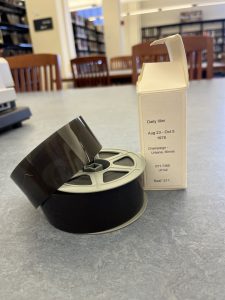The History, Philosophy, and Newspaper Library (HPNL) at the University of Illinois Urbana-Champaign is home to a large collection of both newspapers and microfilm. While both are certainly collections that are still used regularly, there are many people of all generations who have never come into contact with a microfilm reel or scanner before coming here. And really, why would they have too? Everything is accessible on the internet at this point right?

Well not exactly.
In the past, microfilm was used as a form of preservation for more fragile objects like old books and newspapers that were printed on quickly degrading paper. There was a huge boom in the microfilming industry in the 50s and 60s when archivists and librarians became a little bit obsessed with increasing the longevity of their collections and saving space. During this process, however, they threw out many of the original copies of items that were filmed which made them only accessible on microfilm. At the time this probably seemed like a great idea (saving space and all that), but as we have transitioned into the digital age, physical-based media are seeing less and less use.
That dip in use does not reflect microfilm’s overall usefulness, however. People come into our library daily to view microfilm for a variety of reasons. But if these resources are so useful, why are they being used less and less? I can think of a few reasons: Continue reading “Accessibility Issues in the Case of Microfilm (And Why You Should Still Give it a Chance)”